winter tires AUDI S7 2016 Owners Manual
[x] Cancel search | Manufacturer: AUDI, Model Year: 2016, Model line: S7, Model: AUDI S7 2016Pages: 294, PDF Size: 73.82 MB
Page 84 of 294

Driving
Switching the Start-Stop-System on/off
manually
Applies to veh icles: with Sta rt-Stop-System
If you do not wish to use the system, you can
switch it off manually.
F ig . 86 Ce nter con so le: Start -Stop-Syste m button
• To switch the Start-Stop-System off/on manual
ly, press the
1 0• •1 button . The L ED in the button
turns on when t he system is switched off .
(D Tips
If you switch the system off d uring a stop
phase, the engine will start again automati
cally.
Messages in the instrument cluster display
Applies to vehicles: with Start -Stop-System
Start-stop system dea ctivated: Please restart
engine manually
This message appea rs when specific conditions
are no t me t d uring a stop phase and the Sta rt
Stop-System will
not be able to resta rt the en
gine. The engine must be started with the
I S TAR T ENGINE STOP I button.
Start-stop system: System fault! Currently
unavailable
There is a ma lf u nct ion in the Star t-Stop -System .
Drive the veh icle to an authorized repair fac ility
for servic ing as soon as possib le to correct the
malfunct ion.
82
Speed warning system
Introduction
The speed warning system helps you to stay un
der a specified maximum speed .
The speed warning system warns you if you are
exceeding the maximum speed that you have set .
You w ill hear a warning tone when your speed ex
ceeds the sto red val ue by app rox imately 3 mph
(3 km/h) . An indicator light . (USA mode ls)/ .
(Ca nada models) in the ins trumen t cluste r dis
play a lso turns o n at the same time. The ind ic a tor
li ght .,. turns off w hen the speed decrea ses
below the stored maximum speed.
Set ting a t hreshol d is recom mended if you would
lik e to be rem inded when you re ach a cert ain
maximum speed . Si tua tions where you may want
to do so include drivin g in a country w ith a gene r
a l speed limit or if there is a specified max imum
speed for winter tires.
(D Tips
Eve n though your vehicle is eq uipped w ith a
speed warning system, you should still watch
the speedometer to make sure yo u are not
drivi ng faster than the speed lim it.
Setting the threshold
You con set , change and delete the warning
threshold in the Infotainment system.
• Select: the ICAR I function button > (Car)* Sy s
tems
control b utton > Driver ass istance >
Speed warning .
You can set any threshold betwee n 20 mph
(30 km/h) and 150 mph (240 km/h) . Settings
can each be adjusted in increments of 6 mph
(10 km/h) .
Page 194 of 294
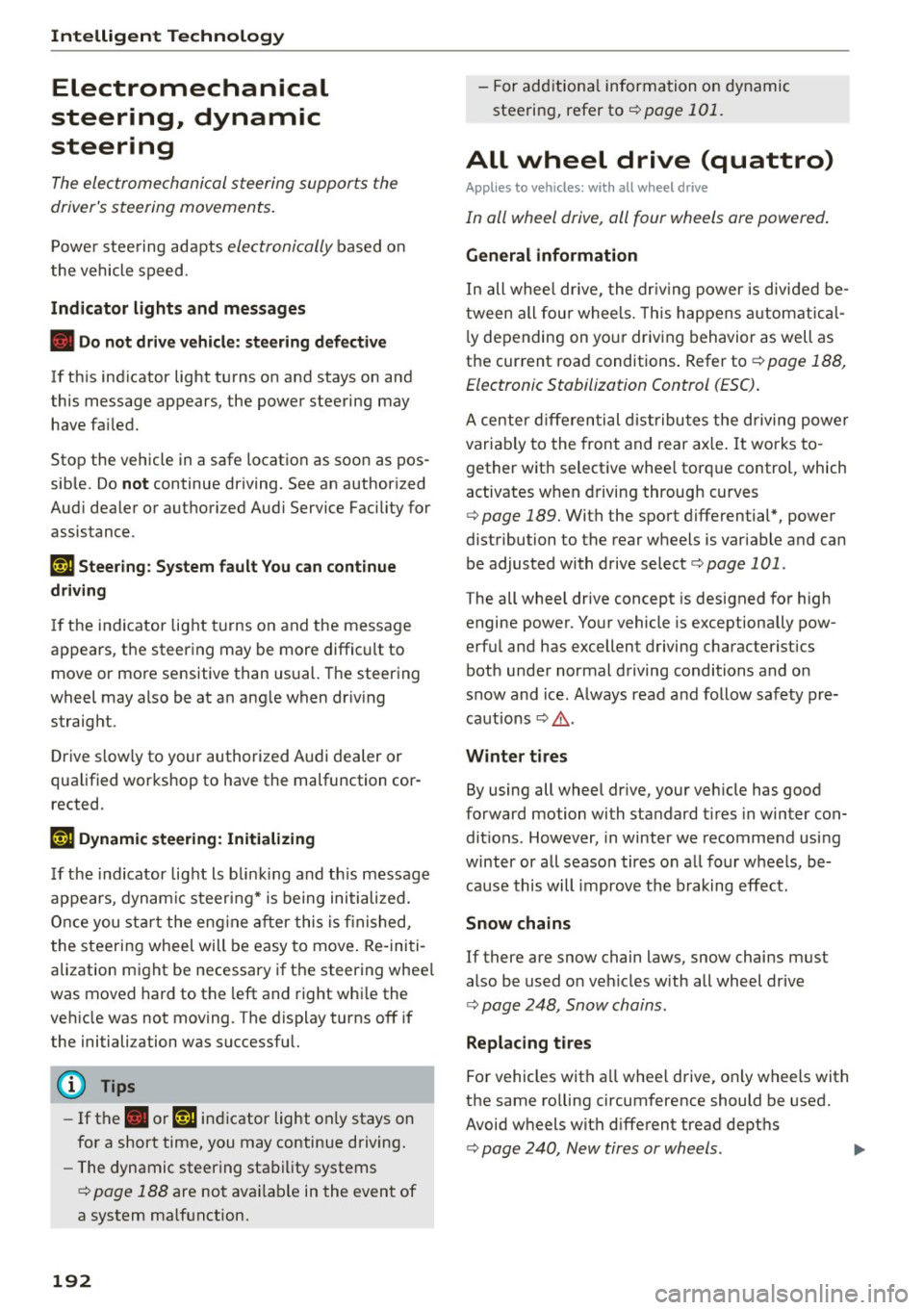
Intelligent Technology
Electromechanical
steering, dynamic
steering
The electromechanical steering supports the
driver's steering movements .
Powe r stee ring adapts electroni cally based o n
the vehicle speed.
Indicator lights and messages
• Do not dr ive v ehicle: steering d efecti ve
If th is ind icator light turns on and stays on and
this message appears, the power steering may have fa iled.
Stop the vehicle in a safe locatio n as soon as pos
sib le. Do
not continue driving. See an author iz ed
Aud i dealer or authori zed Aud i Service Facility for
assistance.
,Ton Steering: Sy stem fault You can continue
driving
If the indicator lig ht t urns on and the message
appears, t he steering may be more diffic ult to
move or more sensitive than usual. The steering
wheel may a lso be at an ang le when dr iv ing
straight.
D rive s low ly to your authorized A udi dealer or
qualified wor kshop to have the malfunction cor
rected.
,Ton Dynamic steering: Initializing
If the indi cator lig ht ls b linki ng and th is message
appears, dynam ic s teeri ng* is being ini tialized.
Once you st art the eng ine a fter this is finished,
the steering wheel will be easy to move . Re -initi
alization might be necessary if the steering whee l
was moved hard to the left and right wh ile the
veh icle was not moving . The display turns off if
the initiali zation was successfu l.
(D Tips
-If th e . or ,Ton indicator light only stays on
for a short time, you may continue driving.
- The dynamic steering sta bility systems
r=> page 188 are not ava ila ble in the event of
a system ma lf u nction.
192
- For add itiona l information on dynamic
steerin g, refer to
r=> page 101.
All wheel drive (quattro)
App lies to vehicles : with all wheel drive
In all wheel drive, all four wheels are powered .
General information
In all whee l dr ive, the dr iv ing power is divide d be
tween all four whee ls. Th is happens automat ic al
l y depending on yo ur driv ing behavior as well as
the cur rent roa d conditions . Refer to r=>
page 188,
Electronic Stabilization Control (ESC).
A cente r d iff eren tial distribu tes the d riving power
variably to the fron t and rear ax le . I t works to
gether w it h select ive whee l torq ue control, which
activates when driving throug h curves
<=> page 189. With the sport differential*, power
distribution to the rear wheels is variable a nd can
be adjusted with drive select<=>
page 101 .
The all whee l drive concept is designed for high
engine power . Yo ur vehicle is exceptionally pow
erfu l and has excellent driving characterist ics
bot h under normal driving conditions and on
snow and ice . Always read a nd follow safety pre
ca utions
<=> ,& .
Winter tires
By using all whee l dr ive, your ve hicle has good
forward motion with sta ndard t ires in winter con
dit ions . However, in winter we recommend usi ng
winter or all seaso n tires on a ll fou r wheels, be
cause this will improve the braking eff ect.
Snow chains
If there are snow chain laws, snow chai ns m ust
also be used o n ve hicles with all wheel drive
r=> page 248 , Snow chains .
Replacing tires
For vehicles with a ll wheel drive, o nly wheels with
the same rolling circum ference should be used.
Avoid w heels with d ifferent tread dept hs
<=> page 240, New tires or wheels. ..,.
Page 235 of 294
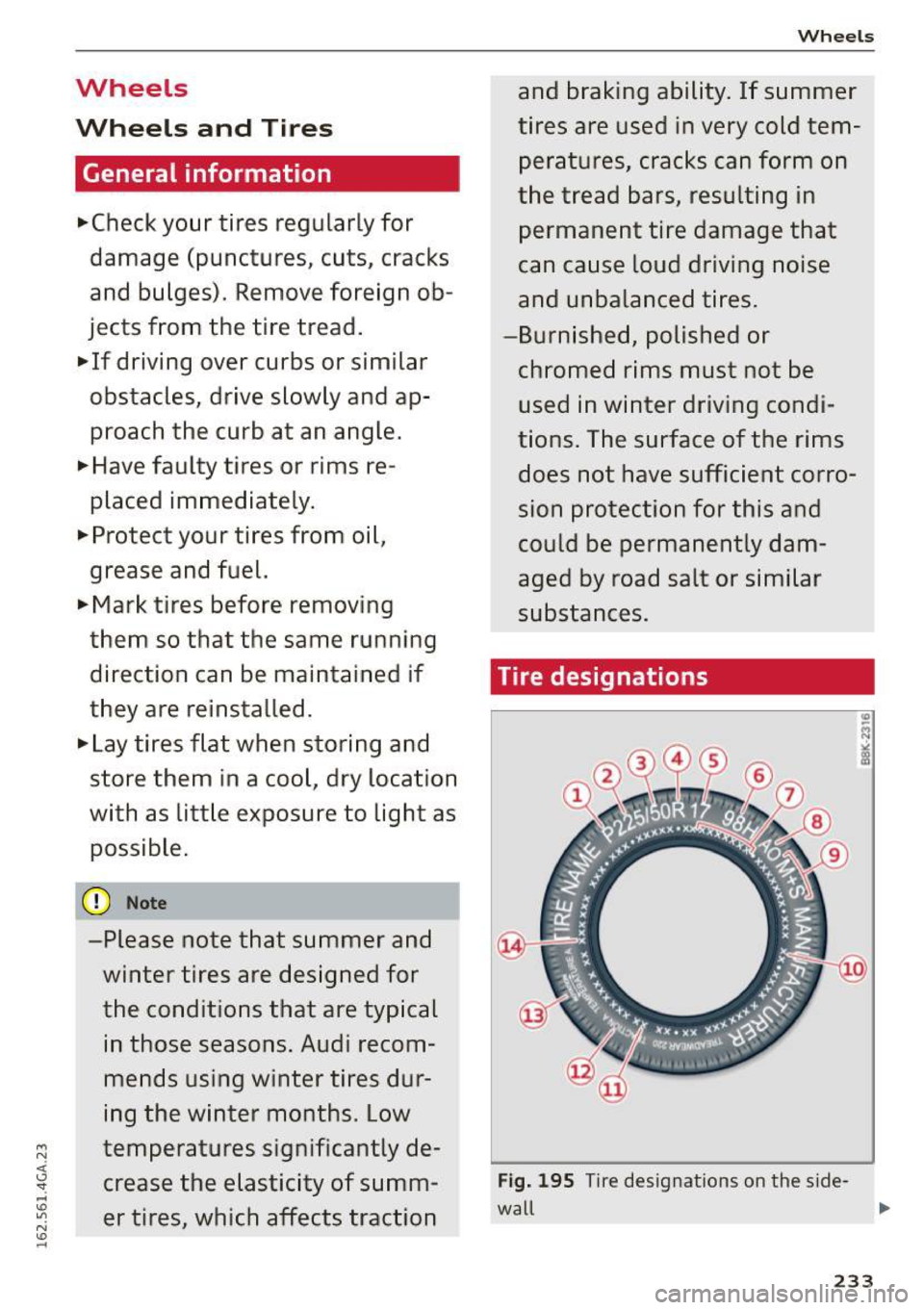
Wheels
Wheels and Tires
General information
.,.Che ck your tires regularly for
damage (punctures, cuts, cracks
and bulges). Remove foreign ob
jects from the tire tread.
.,. If driving over curbs or similar
obstacles, drive slowly and ap
proach the curb at an angle.
.,.Have faulty tires or rims re
placed immediately.
"'Protec t your tires from oil,
grease and fuel.
.,.Ma rk tires before removing
them so that the same running direction can be maintained if
they are reinstalled .
.,.Lay tires flat when storing and
store them in a cool, dry location
with as little exposure to light as
possible.
(D Note
-Please note that summer and
winter tires are designed for
the conditions that are typical
in those seasons. Audi recom
mends using winter tires dur
ing the winter months. Low
temperatures significantly de crease the elasticity of summ
er tires, which affects traction
Wheels
and braking ability. If summer
tires are used in very cold tem
peratures, cracks can form on
the tread bars, resulting in
permanent tire damage that
can cause loud driving noise
and unbalanced tires.
-Burnished, polished or
chromed rims must not be
used in winter driving condi
tions. The surface of the rims
does not have sufficient corro
sion protection for this and
could be permanently dam
aged by road salt or similar
substances.
Tire designations
Fig. 195 T ir e designations on the sid e-
wall ,..
233
Page 236 of 294

Wheels
(D Tires for passenger vehicles
(if applicable)
P indicates a tire for a passenger
vehicle. T indicates a tire desig
nated for temporary use.
@ Nominal width
Nominal width of the tire be
tween the sidewalls in millime
ters. In general: the larger the number, the wider the tire.
@ Aspect ratio
Height/width ratio expressed as a
percentage.
@ Tire construction
R indicates a radial tire.
® Rim diameter
Size of the rim diameter in inches.
@ Load index and speed rating
The load index indicates the tire's
load-carrying capacity.
The speed rating indicates the
maximum permitted speed
¢ & in
Winter tires on page 248.
"EXTRA LOAD", "xl" or "RF" indi
cates that the tire is reinforced or
is an Extra Load tire.
Speed rat- Maximum permitted speed
ing
p
up to 93 mph (150 km/h)
Q up to 99 mph (160 km/h)
234
Speed rat- Maximum permitted speed
Ing
R up t o 106 mph (170 km/h)
s up to 110 mph (180 km/h)
T up to 118 mph (190 km/h)
u up to 124 mph (200 km/h)
H up to 130 mph (210 km/h)
V up to 149 mph (240 km/h)a>
z above 149 mph (240 km/h)a)
w up to 168 mph (270 km/h)a)
y up to 186 mph (300 km/h)a)
a) For tires above 149 mph (240 km/h),
tire manufacturers sometimes use the
code "ZR".
(J) US DOT number (TIN) and
manufacture date
The manufacture date is listed on
the tire sidewall (it may only ap
pear on the inner side of the tire):
DOT ... 2214 ...
means, for example, that the tire
was produced in the 22nd week of
the year 2014.
@ Audi Original equipment
tires
Audi Original equipment tires
with the designation "AO" or "RO"
have been specially matched to
your Audi. When used correctly,
these tires meet the highest standards of safety and handling.
Your authorized Audi dealer will
be happy to provide more infor
mation.
Page 237 of 294

® Mud and snow capability
"M/S" or "M+S" indicates the tire
has characte ris tics that make it
suitable for driving on mud and snow .
& indica tes a winter tire.
@ Composition of the tire cord
and materials
T he number of plies indicates the
number of rubber ized fabric lay
ers in the tire . In general: the
more layers, the more weight a
tire can carry. Tire manufacturers
must also specify the mater ials
used in the ti re. These include
stee l, nylon, polyester and other
materials.
@ Maximum permitted load
This number indicates the maxi
mum load in kilograms and
pounds that the tire can carry .
@ Uniform tire quality grade
standards for treadwear,
traction and temperature resistance
Treadwear , traction and tempera
ture ranges
c::::> page 250 .
@Running direction
The arrows ind icate the running
direction of unidirect ional tires.
You must always follow the speci- fied running direction
c::::> page 259.
€3) Ma
ximum permitted
inflation pressure
Whe els
This number indicates the maxi
mum pressure to which a tire can
be inflated unde r normal operat
ing conditions .
Glossary of tire and loading
terminology
Accessory weight
means the combined weight (in
excess of those standard items
which may be replaced) of auto matic transmission, power steer
ing, power brakes, power win
dows, power seats, radio, and
heater, to the extent that these
items are available as factory-in
stalled equipment (whether in
stalled or not).
Aspect ratio
means the ratio of the height to
the width of the tire in percent. Numbers of 55 or lower indicate a
low s idewall for improved steer
ing response and better overall
handling on dry pavement . .,.
235
Page 240 of 294

Wheels
"XL" "xl" "EXTRA LOAD" or "RF" I I I
on the sidewal l.
Rim
means a metal support for a tire
or a tire and tube assembly upon
which the tire beads are seated .
Rim diameter
means nominal diameter of the
bead seat. If you change yo ur
wheel size , you w ill have to pur
chase new tires to match the new rim diameter .
Rim size designation
means rim diameter and width.
Rim width
means nomina l distance between
rim flanges .
Sidewall
means that port ion o f a t ire be
tween the tread and bead .
Speed rating (letter code)
means the speed at which a tire is
designed to be driven for extend
ed periods of t ime. The rat ings
range from 93 mph (150 km/h)
to 186 mph (298 km/h)
¢ table
on page 234 .
You may not find
this information on all tires be
cause it is not required by la w.
238
The speed rating letter code ,
where applicable , is mo lded on
the tire sidewall and indicates the maximum permiss ible road
speeds
¢ .&. in Winter tires on
page 248.
Tire pressure monitoring
system*
means a system that detects
when one or mo re of a ve hic le's
tires are under inflated and illumi
na tes a low tire p ressu re warning
tellta le .
Tread
means that portion of a tire that
comes into contact w ith the road.
Tread separation
means pu lling away of the tread
from the t ire carcass.
Treadwear indicators (TWI)
means the projections wi thin the
principal grooves designed to give
a visua l indication of the deg rees
of wear of the tread . See
¢ page 242 , Treadwear indicator
for mo re information on measur
ing t ire wear.
Page 242 of 294
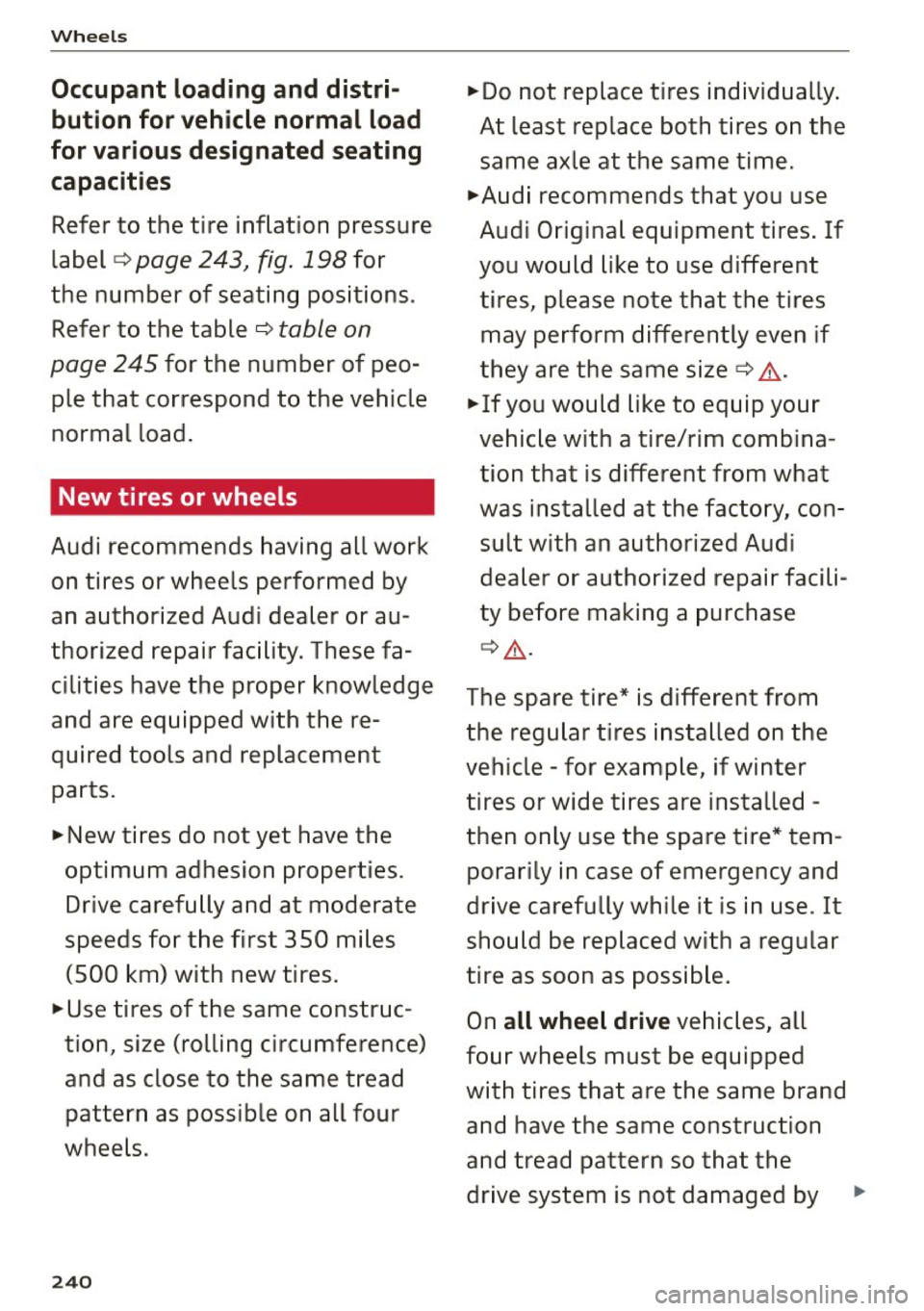
Wheels
Occupant loading and distri
bution for veh icle normal load
for various designated seat ing
capacit ies
Refer to the tire inflation pressure
label
c:> page 243, fig . 198 for
the number of seating positions .
Refer to the table
c:> table on
page 245
for the number of peo
ple that correspond to the vehicle
normal load .
New tires or wheels
Audi recommends having all wo rk
on tires or wheels performed by
an authorized Audi dea ler or au
thorized repair fac ility. These fa
cilities have the proper knowledge
and are equipped with the re
quired tools and replacement
parts.
.,. New tires do not yet have the
optimum adhesion properties. Drive carefully and at moderate
speeds fo r the first 350 miles
(500 km) with new tires .
.,. Use tires of t he same constr uc
tion, size (rolling c ircumference)
and as close to the same tread pattern as possible on all four
wheels.
2 4 0
.,.Do not replace tires individ ually .
At least re place both t ires on the
same axle at the same time.
.,. A udi recommends that you use
Aud i O riginal equipment tires . If
you wo uld li ke to use different
tires, please note that the tires may perform d ifferently even if
they are the same s ize
c:> &. -
.,. If you would like to equip you r
vehic le with a tire/rim combina
tion that is different from what
was installed at the facto ry, con
sult w ith an authorized Aud i
dealer or authorized repair facili
ty be fore making a purchase
¢ .&_ .
The spare tire* is d ifferent from
the regular t ires installed on the
vehicle -for example, if winter
tires or wi de tires are installed -
then only use the spare tire* tem
porar ily in case of emergency and
drive carefully while it is in use . It
s h o u ld be replaced w ith a regular
tire as soon as poss ib le.
On
all wheel drive ve hic les, all
four wheels must be equipped
w ith tires that are the same brand
and have the same construction
and tread pattern so that the
drive system is not damaged by
Page 250 of 294
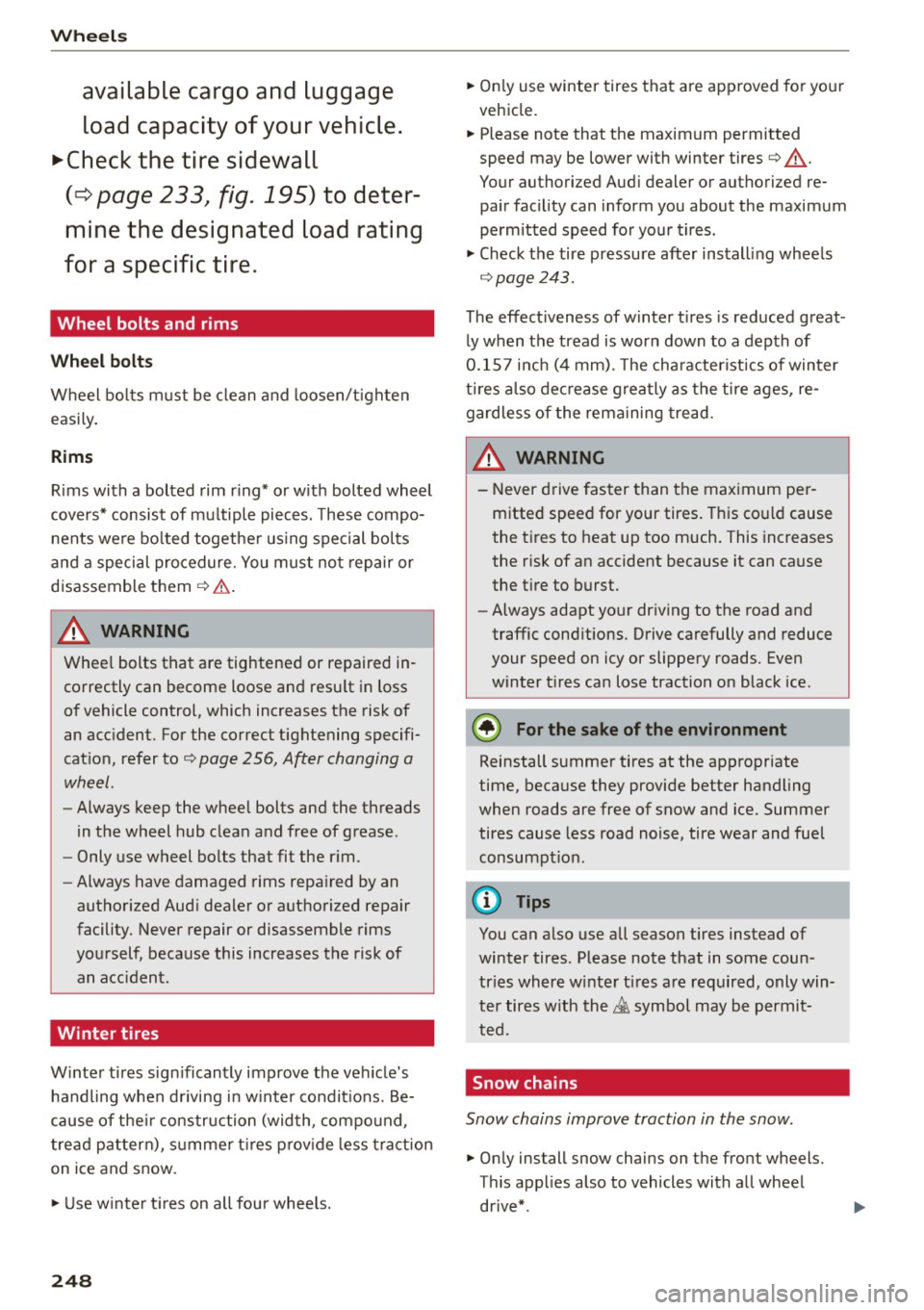
Wheels
av ailabl e cargo and luggag e
l oa d cap aci ty of your v ehi cle.
.,.Che ck th e tire sidew all
(¢ p ag e 233, fig. 1 9 5) to deter
mine the d esigna ted load ra ting
for a specifi c tire .
Wheel bolts and rims
Wheel bolts
Wheel bol ts m ust be clea n and loosen/t ighten
easi ly .
R ims
Rims with a bolted rim r ing* or w ith bolted wheel
covers * consist of mu ltiple piec es. These compo
nents we re bo lted toget he r us ing special bolts
a nd a special pro cedure. You must no t repair or
d isassemble th em ¢.&. .
A WARNING
Whee l bolts t hat are tightened or repaired in
co rrectly can become loose and resu lt in loss
o f vehicle control, which increases the risk of
an acc ident. For the correct tightening specifi
cat ion, refer to
¢ page 2 56, After changing a
wheel .
-Always keep the wheel bolts and the threads
in the wheel hub clean and free of grease .
- Only use wheel bo lts that fit the r im .
- Always have damaged rims repa ired by an
autho rized Aud i dealer or authorized repair
facility. Never repair or disassemble rims
you rself, because this increases the risk of
an acciden t.
Winter tires
Winte r tires sign ificantly improve the ve hicle's
handling when d riving i n w inte r condit io ns. Be
cause of the ir constr uction (wid th, compo und,
trea d patter n), s umme r tires p rov ide less tract ion
on ice and snow .
.,. Use w inte r tir es on all fou r wheels.
248
.,. On ly use winter tires that are approved fo r yo ur
vehicle.
.,. Please note that t he maxim um permitted
speed may be lower with winter tires ¢
_A .
Your authorized Audi dealer or authorized re
pair faci lity can inform you about the maximum
perm itted speed for your ti res .
.,. Check the tire pressure afte r instal ling whee ls
¢ page 243.
The effect iveness of w inter t ires is red uced great
ly when the tread is worn down to a dep th of
0.1 57 i nch ( 4 mm). The cha racterist ics of winter
ti res a lso de crease grea tly as the t ire ages, re
gardless of the remaining tre ad.
A WARNING
-
- Never drive faster than the max imum pe r
m itted speed for your tires. This co uld cause
the t ires to heat up too much . This increases
the risk of an accident because it can cause
the t ire to burst.
- Always adapt your dr iving to the road and
traffic cond itions. D rive carefully and reduce
your speed on icy or slippe ry roads. Even
win ter t ires ca n lose traction on black ice.
@ For the sake of the environment
Reinstall summer tires at the appropriate
time, beca use they provide better handling
when roads are free of snow and ice . Summer
tires cause less road noise, tire wear and fuel
consum ptio n.
(D Tips
You can a lso use all season tires instead of
winter tires. Please note that in some coun
tries where w inter t ires a re requir ed, only win
ter tires w ith the£ symbol may b e permit
ted.
' Snow chains
Snow chains improve traction in the snow .
.,. On ly install snow chai ns on the front w heels.
T his app lies also to vehicles with all wheel
dr ive*.
Page 252 of 294
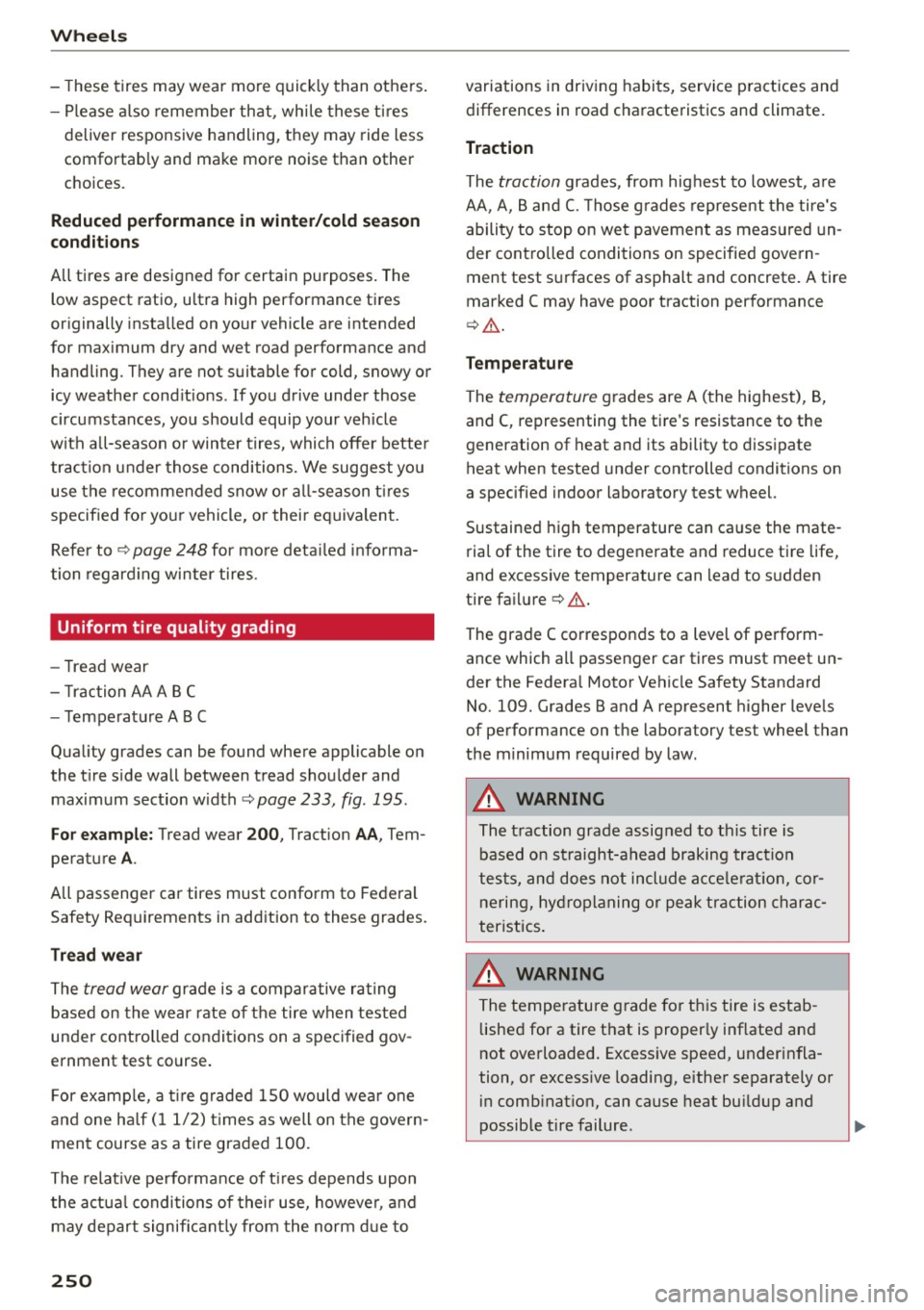
Wheels
-These tires may wear more quickly than others .
- Please also remember that, wh ile these ti res
deliver responsive handling, they may ride less
comfortably and make more noise than other
choices.
Reduced performance in winter/cold season
conditions
All tires are designed for certain purposes. The
low aspect ratio, ultra high performance tires
originally installed on your vehicle are intended
for maximum dry and wet road performance and handling. They are not suitable for cold, snowy or
icy weather conditions. If you drive under those
circumstances, you should equip your vehicle
with all-season or winter tires, which offer better
traction under those conditions. We suggest you
use the recommended snow or all-season tires
specified for your vehicle, or their equivalent.
Refer to ¢
page 248 for more detailed i nforma·
tion regarding winter tires .
Uniform tire quality grading
-Tread wear
- Traction AA A BC
- Temperature ABC
Quality grades can be found where applicable on
the tire side wall between tread shoulder and maximum section width¢
page 233, fig. 195 .
For example: Tread wear 200, Traction AA, Tern·
perature
A.
All passenger car tires must conform to Federal
Safety Requirements in addition to these grades.
Tread wear
The tread wear grade is a comparative rating
based on the wear rate of the tire when tested
under controlled conditions on a specified gov·
ernment test course.
For example, a tire graded 150 would wear one
and one half (11/2) times as well on the govern·
ment course as a tire graded 100.
The relative performance of tires depends upon
the actual conditions of their use, however , and
may depart significantly from the norm due to
250
variations in driving habits, service practices and
differences in road characteristics and climate.
Traction
The traction grades, from highest to lowest, are
AA, A, Band
C. Those grades represent the tire's
ability to stop on wet pavement as measured un
der controlled conditions on specified govern
ment test surfaces of asphalt and concrete. A tire
marked C may have poor traction performance
¢ _& .
Temperature
The temperature grades are A (the highest), B,
and C, representing the tire 's resistance to the
generation of heat and its ability to dissipate
heat when tested under controlled conditions on
a specified indoor laboratory test wheel.
Sustained high temperature can cause the mate·
rial of the tire to degenerate and reduce tire life,
and excessive temperature can lead to sudden
tire failure ¢& .
The grade C corresponds to a level of perform·
ance which all passenger car tires must meet un·
der the Federal Motor Vehicle Safety Standard
No. 109. Grades Band A represent higher levels
of performance on the laboratory test wheel than
the minimum required by law.
A WARNING
-
The traction grade assigned to th is tire is
based on straight-ahead braking traction
tests, and does not include acceleration, cor·
nering, hydroplaning or peak traction charac
teristics.
A WARNING
The temperature grade for this tire is estab
lished for a tire that is properly inflated and
not overloaded. Excessive speed, underinfla·
tion, or excessive loading, either separately or
in combination, can cause heat buildup and
-
possible tire failure. ..,_
Page 254 of 294
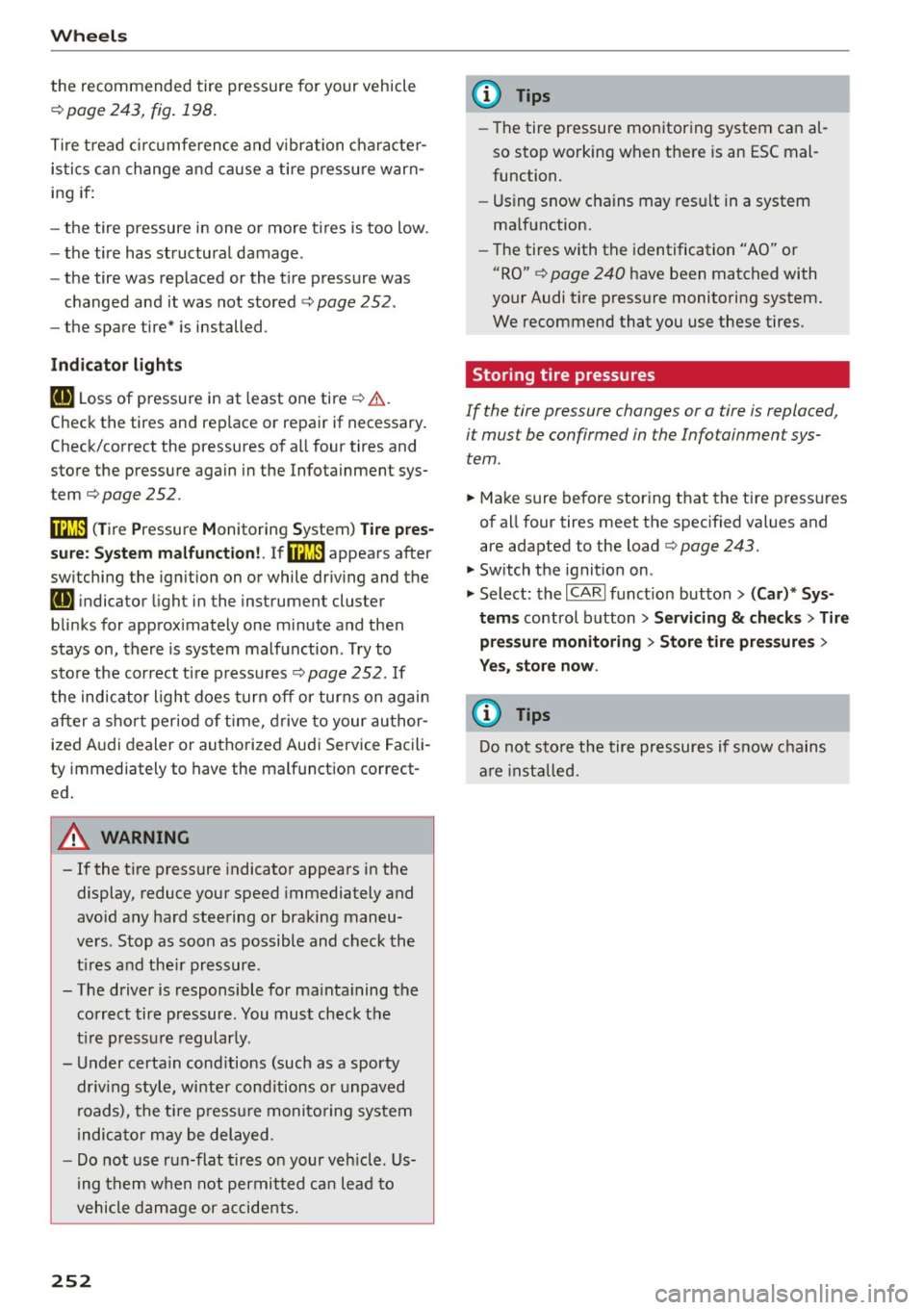
Wheels
the recommended tire pressure for your vehicle
¢ page 243, fig. 198.
Tire tread ci rcumfe rence and v ibration character
istics can change and cause a tire pressure warn
ing if:
- the tire pressure in one or more t ires is too low .
- the tire has structural damage .
- the tire was replaced or the tire pressure was
changed and it was not stored
¢ page 252.
-the spare tire* is installed .
Indicator lights
IE Loss of pressure in at least one tire¢.&. .
Check the tires and replace or repair if necessary.
Check/correct the pressures of all four tires and
store the pressure again in the Infotainment sys
tem
¢page 252 .
mm (Tire Pressure Monitoring System) Tire pres
sure: System malfunction!. Ifffim
appears after
switching the ignition on or while driving and the
IE indicator light in the instrument cluster
blinks for approximately one minute and then
stays on, there is system malfunction . Try to
store the correct tire pressures¢ page 252. If
the indicator light does turn off or turns on again
after a short period of time, drive to your author
ized Audi dealer or authorized Audi Service Facili
ty immediately to have the malfunction correct
ed .
A WARNING
- If the tire pressure indicator appears in the
display, reduce your speed immediately and
avoid any hard steering or braking maneu
vers . Stop as soon as possible and check the
t ir es and their pressure .
- The driver is responsible for maintaining the correct tire pressure. You must check the
tire pressure regularly.
- Under certain conditions (such as a sporty
dr iving style, winter cond itions or unpaved
roads), the tire pressure monitoring system
indicator may be delayed.
- Do not use run-flat tires on your veh icle. Us
ing them when not permitted can lead to
vehicle damage or accidents.
252
(D Tips
-The tire pressure monitoring system can al
so stop working when there is an ESC mal
function.
- Using snow chains may result in a system
malfunction.
- The tires with the identification "AO" or
"RO" ¢
page 240 have been matched with
your Audi tire pressure monitoring system.
We recommend that you use these tires.
Storing tire pressures
If the tire pressure changes or a tire is replaced,
it must be confirmed in the Infotainment sys tem.
... Make sure before storing that the tire pressures
of all four tires meet the specified values and
are adapted to the load¢
page 243 .
... Switch the ignition on .
... Select: the
I CARI function button > (Car)* Sys
tems
control button > Servicing & checks > Tire
pressure monitoring
> Store tire pressures >
Yes, store now.
(D Tips
Do not store the tire pressures if snow chains
are instal led.